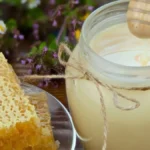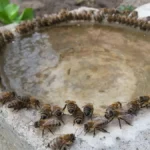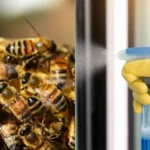In this article, we take a look first at what pasteurization is. Following that we look at why some people pasteurize honey and explore if this is even something you should consider doing.
In order to understand how to pasteurize honey, we first need to look at pasteurization and understand what it is.
Louis Pasteur is one of the great men of modern times. Many of the ideas and technologies he and his team developed have literally shaped modern history and allowed us to have the incredible quality of life we have today.
There is a lot of poverty on Earth, but there is a lot less than there was in his time in the 1800s. Pasteurization has made food safer and allowed billions of young children to escape the diseases that were common before pasteurization was used. But what is pasteurization?
What Is Pasteurization?
If you ask most people what Pasteurization is they will probably say it’s something to do with making milk safe. And yes, that is the case. Pasteur however actually developed the process to make wine and beer stable. Let us walk back a little.
France was the world’s largest producer by value of wine in the 1800s. Wine-making at the time was a bit of a hit-and-miss process and involved the use of wild yeasts. Most modern wine-making today uses strains of yeast which are added to the wine to achieve a controlled fermentation, producing consistent products that are stable and marketable.
Wild Fermentation
In a wild fermentation, the natural yeast and bacteria on the skins of the grapes (and feet of the grape stompers) innoculate the wine. Depending on how this goes you can either end up with exceptional wine, or vinegar. Pasteur found that if you take wine and heat it to between 122°F and 140°F for a short period of time that the resulting product is little changed in taste, but stable and less likely to go sour.
The reason is that heating a product to this temperature kills most living cells. There are still spores that are present, and these can germinate with time and cause trouble. However, in wine, the high alcohol tends to inhibit this.
Milk Pasteurization
The pasteurization of milk was a game-changer. There are many bad things that grow in milk. Milk is an incredibly rich mixture of nutrients and hence bacteria, especially, multiply rapidly in milk. This meant that in a time before widespread access to refrigeration, milk was a leading vector of bacterial illness.
Pasteurization of milk allowed milk to be a safer product that was more stable and this led to the modern global dairy industry. Milk went from being something you collected in a bucket from the person with a cow down the road, to something that got delivered to your doorstep in a glass bottle. You left the empties outside and the next day full bottles appeared courtesy of the milkman. Pasteurization of milk turned it into a product that everybody could use to improve their health and quality of life.
Does Honey Need To Be Pasteurized?
No. But there are times when this can be necessary. Bees collect water to cool their hives and various other hive tasks. If they collect water that is contaminated with sewerage, there is a small chance that some of these microbes can end up in the honey. However, these microbes will be disabled by the honey itself, and hence only their spores will persist. I have seen many people say “Bacterial spores were found in honey from Mexico therefore honey must be pasteurized”.
As we mentioned earlier, pasteurization does not kill spores. In fact, I know for a fact that certain bacterial spores can survive being heated to 249,8°F for an hour. I performed this experiment myself and there are species of bacteria and fungi that can survive this.
If we want to ensure that honey is sterile and free of spores then Irradiation is the only option to ensure it is microbe-free.
Why Do Some People Pasteurize Honey?
If honey is pasteurized it can reduce the risk of honey crystallizing. Honey is a supersaturated solution of water dissolved in sugar. This is a stressful situation for the sugar and it will jump at any excuse to jump out of solution and form sugar crystals. In a situation where sugar is dissolved in water, this tension does not exist. The bees basically trick the sugar into a difficult situation by removing water so quickly the sugar does not have time to crystalize and hence it is trapped in this situation.
If a few small crystals appear, these act as crystallization nuclei, and within a few days or weeks, the entire volume of honey will crystalize and turn into a bock of fudge-like honey. To uneducated consumers, this is unattractive and reduces honey sales.
“Unsightly Honey”
Pasteurizing honey reduces the number of these crystallization nuclei in the honey and provides extended “shelf life” meaning that the honey will not crystalize in the bottles and become “unsightly”.
Read more about: How To Separate Honey From Beeswax
How To Pasteurize Honey
If we look at milk and wine they have low viscosity. This means that they flow easily, and we can run them through a simple heat exchanger where we lift the temperature up quickly and then another heat exchanger to cool them back to room temperature quickly. This allows us to achieve a very controlled heating event that is enough to ensure the inactivation of microbes of concern.
Honey is a thick viscous solution and warming it and cooling it is more of an engineering challenge. Typically we use relatively thick tubes surrounded by a source of heat and then pump the honey down that tube. The flow rate and length of the tube enable the correct heating regime to be followed.
Shell and Tube Heat Exchangers
A shell and tube heat exchanger is probably the most effective method to pasteurize the honey. With these systems, you can accurately control the temperature of the water in the shell. This means that you can avoid overheating your honey. If honey is heated to too high a temperature, it can produce Hydroxymethylfurfural or HMF. This makes the honey dark and is also unhealthy.
These are expensive pieces of equipment and are beyond the scope of what a home beekeeper can use or afford as you need to be processing tons per day of honey to justify this capital investment. If you do need these technologies, there are highly competent food processing companies with trained consultants who can implement a range of filtration and heating options to provide bright stable honey for the shelf.
Does A Home Beekeeper Need To Pasteurize Honey?
This is where we have to ask ourselves a few questions. The customer who goes to a supermarket and buys honey is normally a relatively uneducated customer. Most “shelf honey” is heavily processed and appeals to somebody who wants something that “looks like honey”. This means it needs to be a golden-colored liquid in a bottle. This is the market that large honey packers target, and as a small beekeeper, you do not have the ability to target this market. You need to aim for a niche.
There are people who you can educate into the value of raw unprocessed honey. These are the people who want to buy honey from the beekeeper and pay you in cash. This is a very good thing. And until you get to the point of having at least 100 hives, this is your market. People you sell to at village fairs, farmers’ markets, or by word of mouth.
Marketing Raw Honey
I used to have a trick where I would pop by to “visit a friend” at a workplace at tea time to drop off “a bottle” of honey. I would walk in with a crate of fifty bottles (back damage) and drop off “the bottle”. Normally I would sell at least 30 other bottles to “spontaneous buys” from the other people having tea. All these folks wanted “raw honey” and I made a point of always having a bee wing or leg in a bottle to make it authentic.
Much like there are an increasingly large number of people who are aware that the pink goo that makes up fast-food chicken is not really chicken, an increasingly large number of honey consumers are realizing that the “gold goo” on the shelves of large retailers is not really honey anymore. Choose your market, make your money, know your niche.

I hope this article has helped you realize where and how to position your honey. Embrace your competitive advantages and don’t try to be like the “big boys”. They have made their money, and they have a method. Each new wave of entrepreneurs opens new markets, in new ways. We are moving to a time when “natural” is good. Share if you enjoyed it.
Learn more about: What Is The Difference Between Raw Honey and Pure Honey?
FAQs for “How To Pasteurize Honey”
What is pasteurization?
Pasteurization is a heat treatment process used to kill harmful microorganisms in food and beverages. It was originally developed by Louis Pasteur to make wine stable and safe, and is now commonly used for milk and other products.
Why do people pasteurize honey?
People pasteurize honey mainly to prevent crystallization, making it more appealing to customers. Pasteurization also reduces microbial contamination, though honey naturally inhibits most bacteria.
Does honey need to be pasteurized?
No, honey does not need to be pasteurized. Its natural properties, such as low water content and acidity, already prevent the growth of harmful bacteria. However, pasteurization may be used for cosmetic reasons.
What happens if honey crystallizes?
Crystallized honey is safe to eat but can be seen as unappealing to some consumers. Crystallization happens when sugar molecules in the honey form into solid crystals, turning the honey into a fudge-like texture.
How can you pasteurize honey at home?
To pasteurize honey at home, heat it to 145°F (63°C) for 30 minutes, then cool it quickly. Be careful not to overheat the honey, as this can cause unwanted changes in flavor and color.
Does pasteurization affect the quality of honey?
Yes, pasteurization can reduce the beneficial enzymes and nutrients found in raw honey. It can also alter the flavor slightly, which is why many prefer raw, unprocessed honey.
What equipment is needed to pasteurize honey?
Commercial pasteurization typically requires a shell and tube heat exchanger. For home beekeepers, a double boiler or controlled heating method can suffice, but achieving the precise temperature control needed is more challenging.
Does pasteurization remove bacteria from honey?
Pasteurization kills most bacteria but does not eliminate bacterial spores. However, raw honey is naturally resistant to bacteria due to its high sugar content and low moisture levels.
Can you sell raw honey without pasteurization?
Yes, many home beekeepers sell raw honey, which is preferred by consumers seeking natural, unprocessed honey. Raw honey retains more nutrients and enzymes compared to pasteurized honey.
What are the risks of not pasteurizing honey?
There are minimal risks in not pasteurizing honey because of its natural antibacterial properties. However, contamination from external sources, such as water collected by bees, can introduce bacterial spores, though they rarely pose a health threat.

Dr. Garth A. Cambray is a Canadian/South African entrepreneur and beekeeper with 28 years of experience in apiculture and specializes in adding value to honey. His Ph.D. research developed a new advanced continuous fermentation method for making mead that has resulted in a number of companies globally being able to access markets for mead. His company, Makana Meadery, exports honey mead to the USA where it is available to discerning connoisseurs. He has also developed technologies to commercially manufacture organic honey vinegar in Zambia for export globally. He holds a few patents globally in the ethanol industry and believes in technology and knowledge transfer for human development and environmental sustainability. One of his proudest achievements is the fact that the wind farm he started at one of his old apiary sites has essentially made his hometown carbon neutral.






